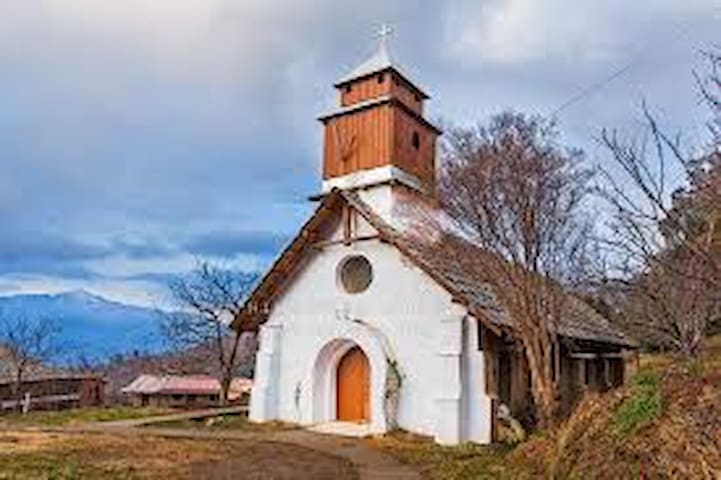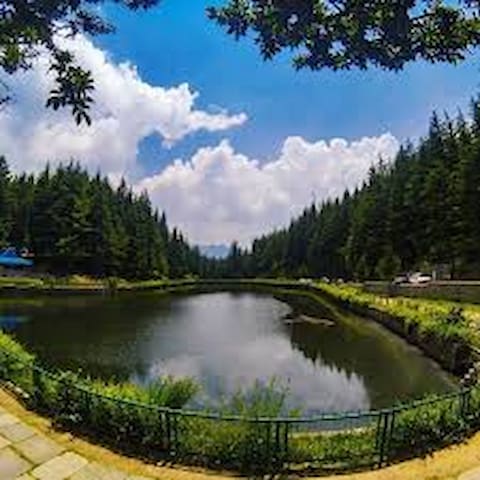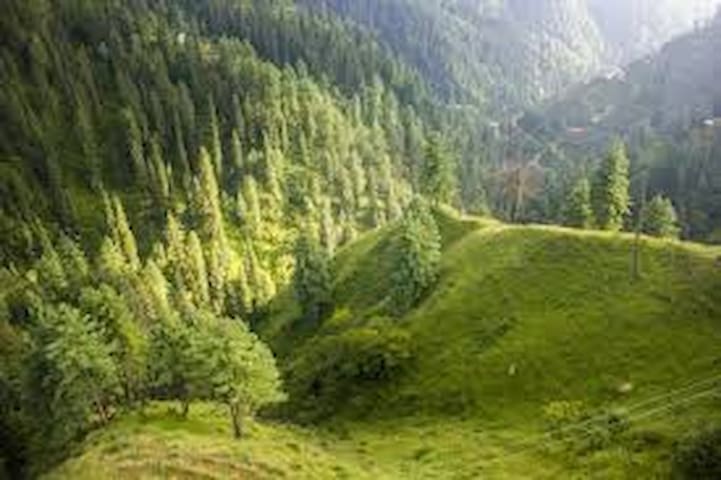Sightseeing
Kotgarh is a small region which is located approximately 12 km from Narkanda. This region is surrounded by Himalayas and town is mainly famous for apples. Apart from Apple region of Himachal pradesh, Kotgarh was one of the earliest mission stations of North India This campus has a missionary school and Church with Gothic architecture... Kotgarh was a part of the province of Punjab. It was Church Missionary Society (CMS) from England that opened its centre at Kotgarh in 1844. It became a mission station along with Simla, Kangra and Dharamsala. Kotgarh was ideally situated in terms of Christianisation.Kotgarh was a station of the British army during the 1814-1816 Gorkha war. A 2 storey building was there to serve as British officers' mess. In the coming years, the British army withdrew from Kotgarh.
This Church stands in the middle of the town and this drew our attention about the place. Kotgarh Church was built in 1872 and it's located near the Army mess.The church is not a very tall building and having a tower bell. The front window has a painting of Christ. The exterior is a combination of austerity and simplicity. It was used for daily morning and evening services.
This church is now filled with mature shrubs and apple trees in its backyard, which enhances overall settings of this place. On other side of the Church a school was opened and was named after Gorton, who was a distinguished servant in Simla. Later this school came under the mission control. The school grew gradually and in 1886 it could boast of a substantial figure of students studying here — 13 boys and two girls. Some medical work was carried at Kotgarh too. A hospital that comprised only four beds was highly beneficial to the natives and the mission societies.Kotgarh with its picturesque location soon became a summer retreat for the missionaries in the plains. Books written during the early 19th century have travelling experiences of missionaries.
Currently Kotgarh does not reflect strong Christian characteristics. However the legacy of the missionaries is depicted in the domain of the church and the school.
Kotgarh
Kotgarh is a small region which is located approximately 12 km from Narkanda. This region is surrounded by Himalayas and town is mainly famous for apples. Apart from Apple region of Himachal pradesh, Kotgarh was one of the earliest mission stations of North India This campus has a missionary school and Church with Gothic architecture... Kotgarh was a part of the province of Punjab. It was Church Missionary Society (CMS) from England that opened its centre at Kotgarh in 1844. It became a mission station along with Simla, Kangra and Dharamsala. Kotgarh was ideally situated in terms of Christianisation.Kotgarh was a station of the British army during the 1814-1816 Gorkha war. A 2 storey building was there to serve as British officers' mess. In the coming years, the British army withdrew from Kotgarh.
This Church stands in the middle of the town and this drew our attention about the place. Kotgarh Church was built in 1872 and it's located near the Army mess.The church is not a very tall building and having a tower bell. The front window has a painting of Christ. The exterior is a combination of austerity and simplicity. It was used for daily morning and evening services.
This church is now filled with mature shrubs and apple trees in its backyard, which enhances overall settings of this place. On other side of the Church a school was opened and was named after Gorton, who was a distinguished servant in Simla. Later this school came under the mission control. The school grew gradually and in 1886 it could boast of a substantial figure of students studying here — 13 boys and two girls. Some medical work was carried at Kotgarh too. A hospital that comprised only four beds was highly beneficial to the natives and the mission societies.Kotgarh with its picturesque location soon became a summer retreat for the missionaries in the plains. Books written during the early 19th century have travelling experiences of missionaries.
Currently Kotgarh does not reflect strong Christian characteristics. However the legacy of the missionaries is depicted in the domain of the church and the school.
The scenic beauty of these small destination become even more brighter because of the apple orchard which can be found every where in this lush green beautiful valley, near to famous tourist place Narkanda in Shimla.
Tani Jubber Lake: The small beautiful lake with fresh water in the midst of deodar forest. Tani Jubber is about 11 KM from Narkanda on Narkanda Thanedar road, Thanedhar is about 5 kM from the lake, There is a temple of local deity (Naag Devta Temple) near the lake. A small park is also maintained in the forest for walk through the forest. Now some guest houses are also found near the lake, this place is very good for picnic and day out trip.
TaniJubbar Gölü ayrıca Tani Jubbar
The scenic beauty of these small destination become even more brighter because of the apple orchard which can be found every where in this lush green beautiful valley, near to famous tourist place Narkanda in Shimla.
Tani Jubber Lake: The small beautiful lake with fresh water in the midst of deodar forest. Tani Jubber is about 11 KM from Narkanda on Narkanda Thanedar road, Thanedhar is about 5 kM from the lake, There is a temple of local deity (Naag Devta Temple) near the lake. A small park is also maintained in the forest for walk through the forest. Now some guest houses are also found near the lake, this place is very good for picnic and day out trip.
Thanedar: Thanedhar is a small town on old Hindustan-Tibet Highway about 15 KM from Narkanda and 80 KM from Shimla, at an average height of 2300 meter. Thanedhar is famous of Apple cultivation, uphold a magnificent panorama of mountains and valleys, The view of Satluj river which flows 6000 ft down clearly visible on sunny day, whole area is covered with thick forest and apple orchards. Hotels, guest houses and rest houses are available here for stay
Thanedhar Road
Thanedhar RoadThanedar: Thanedhar is a small town on old Hindustan-Tibet Highway about 15 KM from Narkanda and 80 KM from Shimla, at an average height of 2300 meter. Thanedhar is famous of Apple cultivation, uphold a magnificent panorama of mountains and valleys, The view of Satluj river which flows 6000 ft down clearly visible on sunny day, whole area is covered with thick forest and apple orchards. Hotels, guest houses and rest houses are available here for stay
Hatu Peak is the highest peak in the entire Shimla district, located in Narkanda. Surrounded by majestic mountains and covered in a dense green blanket of sky touching cedar and fir, Hatu Peak may just be paradise on earth. The forest is a mixed one, comprising a varied population of deodar, fir, spruce, cedar and blue pine; but is mostly renowned for its colourful apple orchards. The Hatu Mata Temple rests atop the hill on Hatu Peak and holds great religious significance to the locals. The temple is dedicated to Mandodari, the wife of King Ravana. Rewarding its visitor with a view of the lush green alpine that sweeps across the landscape, Hatu Peak stands tall and strong as it decorates every square inch of the peak.
Adding to the peak's historical and cultural significance is a small stove like formation that sits right next to the temple, which is believed to have been used by the Pandava brothers for cooking their food during the Agyaat Vaas! Such a rich landscape and stunning view are bound to invite the lovers of the green, and hence, Hatu Peak is a very popular trekking spot for many. The trek is not very rigorous and is a one-way hike of 7 km to the peak. One can also go camping in Hatu Peak and enjoy under the stars in the tent.
Offering a spectacular view of nature's wondrous creations and housing points of religious and historical importance, the Hatu Peak is an all-in-one destination for anyone looking for a spiritual experience, an adventure packed excursion or some peaceful quality time to spend with friends and family.
18 yerel halk öneriyor
Hattu Peak
Hatu Road Hatu Peak is the highest peak in the entire Shimla district, located in Narkanda. Surrounded by majestic mountains and covered in a dense green blanket of sky touching cedar and fir, Hatu Peak may just be paradise on earth. The forest is a mixed one, comprising a varied population of deodar, fir, spruce, cedar and blue pine; but is mostly renowned for its colourful apple orchards. The Hatu Mata Temple rests atop the hill on Hatu Peak and holds great religious significance to the locals. The temple is dedicated to Mandodari, the wife of King Ravana. Rewarding its visitor with a view of the lush green alpine that sweeps across the landscape, Hatu Peak stands tall and strong as it decorates every square inch of the peak.
Adding to the peak's historical and cultural significance is a small stove like formation that sits right next to the temple, which is believed to have been used by the Pandava brothers for cooking their food during the Agyaat Vaas! Such a rich landscape and stunning view are bound to invite the lovers of the green, and hence, Hatu Peak is a very popular trekking spot for many. The trek is not very rigorous and is a one-way hike of 7 km to the peak. One can also go camping in Hatu Peak and enjoy under the stars in the tent.
Offering a spectacular view of nature's wondrous creations and housing points of religious and historical importance, the Hatu Peak is an all-in-one destination for anyone looking for a spiritual experience, an adventure packed excursion or some peaceful quality time to spend with friends and family.
The Kali Bari Temple, one of the ancient temples of the city, was built in 1845. Dedicated to the fearsome reincarnation of Goddess Kali, known as Shyamala, the Goddess is believed to have existed near Jakhoo. The shrine of the blue Goddess existed near Rotheny Castle on Jakhoo before it was shifted to a place, known as Kali Bari at present.
In the temple, a wooden image of the Goddess Kali in the form of Shyamala is worshipped. The original altar at the shrine was established by the Bengali devotees as per historians.
Goddess Kali is worshipped in the forms like Bhavani, Bhadrakali, Cchinnamasta, Chamunda, Durga, Himavati, Kumari Sati, Kamakshya, Meenakshi, Parvati, Rudrarani, Tara and Uma at the shrine.
One of the popular shrines of the city, the Kali Bari Temple receives a heavy influx of devotees on the auspicious occasion of Navratri and Durga Puja. Located in close vicinity to the Shimla city mall, the temple can be reached by foot.
6 yerel halk öneriyor
Kali Bari Tapınağı
Mall RoadThe Kali Bari Temple, one of the ancient temples of the city, was built in 1845. Dedicated to the fearsome reincarnation of Goddess Kali, known as Shyamala, the Goddess is believed to have existed near Jakhoo. The shrine of the blue Goddess existed near Rotheny Castle on Jakhoo before it was shifted to a place, known as Kali Bari at present.
In the temple, a wooden image of the Goddess Kali in the form of Shyamala is worshipped. The original altar at the shrine was established by the Bengali devotees as per historians.
Goddess Kali is worshipped in the forms like Bhavani, Bhadrakali, Cchinnamasta, Chamunda, Durga, Himavati, Kumari Sati, Kamakshya, Meenakshi, Parvati, Rudrarani, Tara and Uma at the shrine.
One of the popular shrines of the city, the Kali Bari Temple receives a heavy influx of devotees on the auspicious occasion of Navratri and Durga Puja. Located in close vicinity to the Shimla city mall, the temple can be reached by foot.
Mall Road is the main street in Shimla, the capital city of Himachal Pradesh, India. Constructed during British colonial rule, the Mall road is located a level below the ridge. The offices of municipal corporation, fire service, and police headquarters are located here
Mall Road
Mall RoadMall Road is the main street in Shimla, the capital city of Himachal Pradesh, India. Constructed during British colonial rule, the Mall road is located a level below the ridge. The offices of municipal corporation, fire service, and police headquarters are located here
Kufri is a location 16 km from Shimla which has a famous historic backdrop, for its ski slopes and finished views. Known for its ski runs Kufri, attracts some of the largest numbers of travellers from far and wide, coming to visit Shimla. One may find peaks covered with snow and a small zoo in the area where Yak rides are an additional attraction.
45 yerel halk öneriyor
Kufri
Kufri is a location 16 km from Shimla which has a famous historic backdrop, for its ski slopes and finished views. Known for its ski runs Kufri, attracts some of the largest numbers of travellers from far and wide, coming to visit Shimla. One may find peaks covered with snow and a small zoo in the area where Yak rides are an additional attraction.
sight seeing
The Ridge road is a large open space, located in the center of Shimla, the capital city of Himachal Pradesh, India. The Ridge is the hub of all cultural activities of Shimla. It is situated along the Mall Road, which is the famous shopping center of Shimla. Most major places of Shimla like Snowdon, Mall, Jakhoo hill, etc. are connected through the Ridge.
Ridge
The Ridge road is a large open space, located in the center of Shimla, the capital city of Himachal Pradesh, India. The Ridge is the hub of all cultural activities of Shimla. It is situated along the Mall Road, which is the famous shopping center of Shimla. Most major places of Shimla like Snowdon, Mall, Jakhoo hill, etc. are connected through the Ridge.




